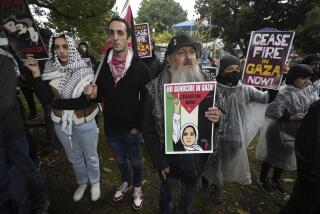Better Late Than Never--Sephardic Jews Savor Spain’s Apology : Religion: 500 years after their ancestors were exiled, community welcomes gesture of reconciliation.
NEWPORT, R.I. — Five hundred years after the Jews were deported from Spain on the same tide that carried Columbus to the New World, America’s oldest synagogue has survived to hear a king and president welcome them back to the Iberian Peninsula.
The president, Mario Soares of Portugal, came in person.
“He sat right here in George Washington’s chair and publicly apologized to Jews everywhere, asking forgiveness for the suffering and pain his country had inflicted,” said the Rabbi Chaim Shapiro, recalling that emotional day three years ago in Newport’s Touro Synagogue.
“He admitted the expulsion of the Jews was the greatest mistake Spain and Portugal ever made. They deprived themselves of leaders in the fields of medicine, science, philosophy, administration, finance and lost the intellectual balance needed to offset the religious fanaticism of the time. After that, Spain and Portugal went into decline.”
Then on March 31 of this year, the 500th anniversary of King Ferdinand and Queen Isabella’s expulsion order, the Touro congregation received with joy and tears the news that King Juan Carlos of Spain, wearing a yarmulke, had prayed with President Chaim Herzog of Israel in Beth Yaakov, Madrid’s only synagogue, in a gesture of reconciliation.
“The king’s gesture,” Shapiro told the congregation, “does more than confer legitimacy on the small Jewish community now living in Spain, some of whom were smuggled in during the Holocaust. It pays homage to Sephardic communities scattered around the world, who like ours have never forgotten their Spanish roots.”
Sepharad is the Hebrew word for Spain. In Jewish tradition it is associated with the biblical land of Sepharad, mentioned in the book of Obadiah, where Jewish wanderers settled after the Babylonians captured Jerusalem and destroyed King Solomon’s temple, instituting the First Diaspora.
Jews had lived in Spain for more than 1,500 years when the royal order was issued “that all Jewish men and women of all ages leave our kingdoms by the end of July, with their sons and daughters, servants and relatives who are Jews . . . with the warning that any who are found here or return will incur the death penalty.”
Unfavorable winds and tides delayed the expulsion deadline, so that on Friday, Aug. 3, 1492, Columbus had to set sail from the small port of Palos because the harbors at Seville and Cadiz were jammed with ships taking away the last of this human cargo. Some boarded ships sent by the sultan of the Ottoman Empire who thought the Spanish king and queen were out of their minds to reject such a talent pool. Even the maps and navigation charts Columbus took with him were prepared by Jewish astronomers and mathematicians.
Many families took their house keys with them, hoping someday to return. All took with them Ladino, a sort of Spanish Yiddish, a strange medieval language rich in prayer, poetry, song and story, that is read right to left like Hebrew.
Shapiro told his congregation that several of his rabbinical colleagues felt the anniversary was a time for mourning and wondered if participating in Spain’s Columbus quincentennial “wasn’t tantamount to accepting a flagrant bribe in order to encourage Jewish tourism and avoid any embarrassing protests that might mar the Barcelona Olympics and other events taking place in Spain this year?”
He, however, preferred “to accept Spain’s hand of friendship outstretched in a symbolic act of repentance and at the same time to celebrate the survival of Sephardic communities over the most difficult obstacles imaginable.”
With a running commentary, the rabbi led the way into America’s oldest synagogue, now a national landmark. In a large glass case to the left of the altar, Shapiro proudly pointed to a 500-year-old Torah, the scroll containing the first five books of the Bible. “This was written on deerskin parchment in Spain just before the congregation was told to convert to Catholicism or get going.”
The “president’s pew,” where Soares sat, was twice occupied by Washington: first when he came to Newport to plan the Yorktown campaign with Adm. Jean Rochambeau, then later as president.
The general felt a genuine affinity with the community. Sephardic Jews like Lion Moses, Isaac Franks and Haym Salomon helped finance the American Revolution. A Col. David Franks was Washington’s liaison officer to Benjamin Franklin in Paris. Then there was the fabled midnight ride to Haym Salomon. With Washington’s unpaid troops threatening mutiny, a messenger on horseback arrived at the Philadelphia synagogue on the eve of Yom Kippur, 1779. Salomon immediately left the service and raised $400,000 to meet the payroll.
Framed on the back wall is a letter Washington wrote to the congregation assuring them that the new “government of the United States gives to bigotry no sanction, to persecution no assistance, requiring only that they who live under its protection shall demean themselves as good citizens.”
Shapiro says the president’s “promise of religious freedom even before the Bill of Rights was adopted meant a great deal to a people who were understandably nervous about any new government, especially after all they’d been through. His letter is read aloud every year in the synagogue.”
As if demonstrating the anxiety of his ancestors, the rabbi suddenly reached down to the floor of the reading platform at the center of the synagogue and yanked open a trap door. It led down a steep ladder to a stone floor far below and a long dank tunnel. Here was a haunting reminder of the dark Spanish past when Jews called marranos --Spanish slang for pigs--practiced their religion in secret to avoid the flailing whips and immolating bonfires of the Inquisition.
“Who knows whether it was real or symbolic? Why did my grandmother go to the basement every Friday night and light a candle? Later, some say, the tunnel was part of the underground railroad smuggling slaves to freedom. Just up the street is America’s first free black church.”
On the opposite back wall is a plaque to the first rabbi: “Rev. Isaac Touro, born 5495, died Tebet 14, 5544,” which translates from the Hebrew calendar: 1738 to mid-winter, 1787. His sons Abraham and Judah were among America’s first philanthropists, endowing the Touro Infirmary in New Orleans and what became the Massachusetts General Hospital, along with parks, orphanages and synagogues in a number of cities.
Banished Jews who did not board the ships of the sultan of the Ottoman Empire first crossed the border into Portugal. Expelled from there, they wandered in a variety of directions: to Morocco, the Balkans, Greece, the Italian states, Amsterdam, the Dutch islands of the West Indies and northern Brazil, which was briefly ruled by Holland.
“Some ended up in, of all places, Nieuw Amsterdam,” said David Gitlitz, who teaches a course called “Spain, the Jews and the Inquisition” at nearby Rhode Island University. “Gov. Peter Stuyvesant did not welcome them with the religious tolerance that was unique under the Dutch flag. He forbade them to own homes or engage in trade. Fortunately, Jewish investors owned 25% of the Dutch West Indies Company and he was very soon told to put the brakes on his bigotry.”
The tiny Colonial Jewish Cemetery is just a short walk up Touro Street from the synagogue, at the corner of Zion Place and the start of Bellevue Avenue, which used to be called Jew Street before the Vanderbilts, the Belmonts and the Astors built palatial summer “cottages” with names like “The Breakers,” “Rosecliff,’ “Marble House,” and “Beechwood.”
“Almost the first thing an immigrant group would do, even before building a synagogue, was to buy land for a cemetery and form a burial society,” Gitlitz says.
Shapiro thinks the Jews came to Rhode Island because “that maverick minister Roger Williams founded the only colony which welcomed people who were different to come and settle. Here was an English Christian colony offering Dutch Jews what had to be the forerunner of religious freedom in America. The first known burial in our cemetery was Joseph Franzon, whose body was smuggled in from Massachusetts on a raft so he could at least rest as a Jew in holy ground.”
The congregation of the synagogue declined steadily after the British ransacked the town and burned the wharves where Aaron Lopez and his relatives made their fortunes. Lopez was engaged in what Newporters euphemistically call the “triangular trade.” Newport traded rum to Africa for slaves, who were transported to the West Indies to cultivate the sugar that sustained Newport’s 22 distilleries.
When there was no longer a minyan , the minimum of 10 men needed to hold a service, the keys to Touro were handed over for a time to its sister synagogue, Shearith Israel in New York, which still is the legal owner, approves the choice of a rabbi and collects $1 a year in rent. The New York congregation is older, but its synagogue is a modern structure.
The Touro congregation now numbers 140 families and, says Shapiro, “tries hard to maintain the Sephardic traditions, which over the centuries have been our formula for survival, although now a majority are from the Ashkenazi Jewish background.” The Ashkenazi Jews came primarily from Eastern Europe.
“What’s changing Sephardic communities rapidly is intermarriage with Ashkenazis,” says Gitlitz. “It’s almost universal. In this country the intermarriage rate for Sephardic Jews is up over 60%. Most Sephardic kids marry non-Sephardics, which means great dilution in a couple of generations.”
Gitlitz says Sephardic communities in America were overwhelmed at the turn of the century by a massive Ashkenazi immigration of 2 million to 3 million, outnumbering the Sephardics by 100 to one. “Almost from the day they got off the boat, American Judaism was defined as Ashkenazi,” he says.
And the future?
“Civilizations don’t die, they change,” the professor replies. “Sephardic communities are evolving pretty rapidly, becoming secularized in ways they didn’t used to be. For this generation, the culture is being reduced to a few phrases and a tradition of cooking.”
Looking back five centuries, Gitlitz finds one positive consequence of the expulsion of the Jews from Spain.
“The new diaspora allowed Sephardic culture to flourish in a whole variety of different environments,” he says. “It became tremendously interesting and vital. None of this would have happened had the Jews not been banished. You wouldn’t have the exciting cultures of Turkish or North African or Dutch Judaism.”
Nor would you have the cautious boast of the elderly lady with the Sephardic name of Levy who was asked at a Newport dinner party if it were true that her family could trace itself back to King Solomon.
“Well,” she replied, “at the time of the Crucifixion, it was said so,” she says.
More to Read
Sign up for Essential California
The most important California stories and recommendations in your inbox every morning.
You may occasionally receive promotional content from the Los Angeles Times.










